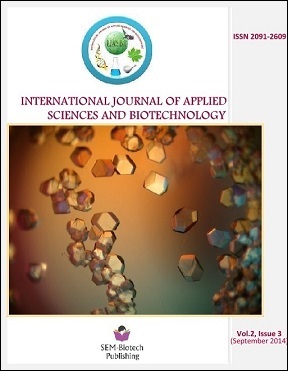Genetic Diversity Assessment of Acid Lime (Citrus Aurantifolia Swingle) Landraces of Eastern Nepal Using RAPD Markers
DOI:
https://doi.org/10.3126/ijasbt.v2i3.10950Keywords:
Lime, Citrus, molecular marker, Polymerase Chain Reaction, PCRAbstract
Acid lime (Citrus aurantifolia Swingle) is an important commercial fruit crop, cultivated from terai to high hill landscapes of Nepal. However, production and productivity is very low due to various reasons including infestations by various diseases and pests, lack of diseases and pests resistant and high yielding varieties. In this context, determination of genetic variation at molecular level is fundamental to citrus breeders for the development of elite cultivars with desirable traits. In the present study, Random Amplified Polymorphic DNA (RAPD) marker technique has been employed to assess genetic diversity in 60 acid lime landraces representing different agro-ecological zones of eastern Nepal. Nine selected arbitrary primers generated 79 RAPD fragments of which 75 were polymorphic (94.94%). Phenogram was constructed by NTSYSPC ver. 2.21i using UPGMA cluster analysis based on Jaccard’s similarity coefficient to deduce overall genetic diversity and relationships of the acidlime genotypes under study. Sixty acid lime landraces formed seven clusters and similarity value ranged from 38% to 98% with an average of 72%. Genetic variation at different agro-ecological zones was assessed using Popgene ver. 1.32 and found 47% to 69.6% polymorphism. Shannon’s index and Nei’s gene diversity showed highest level of acid lime diversity in Terai zone (PPB, 69.62%; H, 0.213; I, 0.325) followed by mid-hill zone (PPB, 67.09%; H, 0.208; I, 0.317). The results obtained will be useful to citrus breeders for elite cultivar development. The RAPD-PCR technique is found to be the rapid and effective tool for genetic diversity assessment in acid lime landraces of Nepal.
DOI: http://dx.doi.org/10.3126/ijasbt.v2i3.10950
Int J Appl Sci Biotechnol, Vol. 2(3): 315-327




